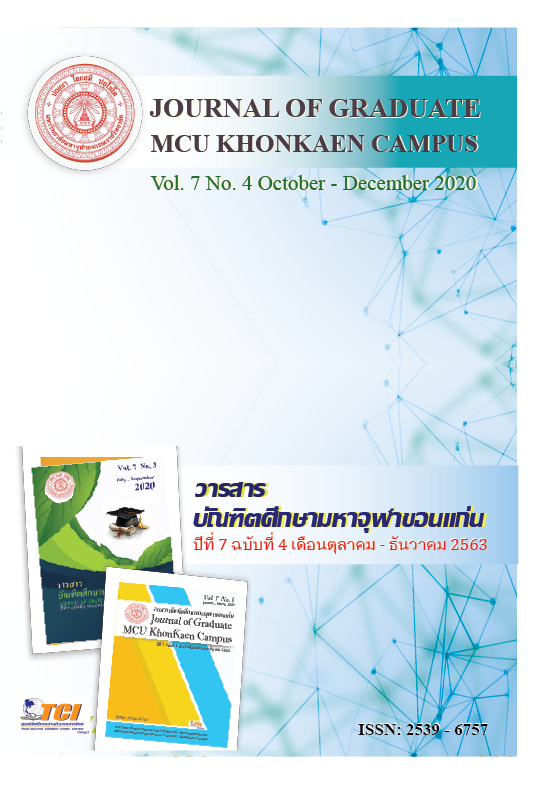THE EDUCATIONAL ENVIRONMENT MANAGEMENT ACCORDING TO THE FOUR SAPPAYA PRINCIPLES OF PHRAPARIYATTI-DHAMMA SCHOOLS, GENERAL EDUCATION DEPARTMENT, KHONKAEN PROVINCE
Main Article Content
Abstract
The purposes of this research were: 1) to study the management of education environment based on the four Sappāya (advantageous conditions) principles of Phrapariyatti-dhamma schools, General Education Department, Khon Kaen province; 2) to compare the management of education environment based on the four Sappāya principles based on the personal factors of the samples: positions, educational background and work experience; 3) to propose the ways of the management of education environment based on the four Sappāya principles for the mentioned Phrapariyatti-schools. This study was carried out by means of mixed methodology research to collect the data from the population including 374 administrators and teachers. The research tools were the interview form and questionnaire with its reliability value of 0.97.
The research results are as follows:
1) In the management of education environment based on the four Sappāya (advantageous conditions) principles of Phrapariyatti-dhamma schools, General Education Department, Khon Kaen province, the administrators and teachers had their opinion on the aforesaid management at a high level of practice. The highest mean is seen in the aspects of management based on Bhojana-sappāya (suitable food) and Puggala-sappāya (suitable person). In these aspects, there is a continuous training for personnel development in all educational institutions and there is encouragement for teachers, students and communities to participate in the organization of the school environment. There is sufficient food management for students. In the physical aspect based on Āvāsa-sappāya (suitable abode), there is arrangement of an outdoor location or courtyard to facilitate various activities and the school clearly displays the plan about the various buildings and the environment in the school is shady, beautiful, clean and comfortable. In the aspect of academic based on Dhamma-sappāya (suitable teaching), there is reinforcement for students, such as the award of consolation that helps to improve learning. The school has labels for Buddhist teachings, proverbs, or poems in the educational area. The teacher gives students the opportunity to comment and participate in carrying out various activities within the school.
Article Details
References
นัฐภัค อุทโท. (2558). การจัดสภาพแวดล้อมทางการเรียนทางกายภาพของโรงเรียนอนุบาลวัดช่องลม สํานักงานเขตพื้นที่การศึกษาประถมศึกษาชลบุรี เขต 1. ในวิทยานิพนธ์การศึกษามหาบัณฑิต สาขาวิชาการบริหารการศึกษา : มหาวิทยาลัยมหาวิทยาลัยบูรพา.
พระลิขิต นนฺทปญฺโญ (เมืองจันทร์). (2560). รูปแบบการจัดการสัปปายะในสํานักปฏิบัติธรรมภาคตะวันออกเฉียงเหนือของประเทศไทย. วารสารบัณฑิตศึกษาปริทรรศน์, 13(ฉบับพิเศษ)(3), 34-45.
ภัชราภรณ์ โพธิสัย. (2558). สภาพแวดล้อมทางการเรียนของนักเรียนบ้านนาคำนาใน สังกัดสำนักงานเขตพื้นที่การศึกษาประถมศึกษาบึงกาฬ. ในวิทยานิพนธ์การศึกษามหาบัณฑิต สาขาวิชาการบริหารการศึกษา : มหาวิทยาลัยบูรพา.
สำนักงานกลุ่มโรงเรียนพระปริยัติธรรมกลุ่มที่ 7. (2559). แผนยุทธศาสตร์การพัฒนา การศึกษาพระปริยัติธรรมแผนกสามัญศึกษา. กองพุทธศาสนศึกษาสำนักงานพระพุทธศาสนาแห่งชาติ.
อมรพงศ์ พันธ์โภชน์. (2556). การบริหารสภาพแวดล้อมในสถานศึกษาขั้นพื้นฐานของกลุ่มลําภู - บางนาค สํานักงานเขตพื้นที่การศึกษาประถมศึกษานราธิวาส เขต 1. ในวิทยานิพนธ์ครุศาสตรมหาบัณฑิต สาขาวิชาการบริหารการศึกษา : มหาวิทยาลัยราชภัฏยะลา.

